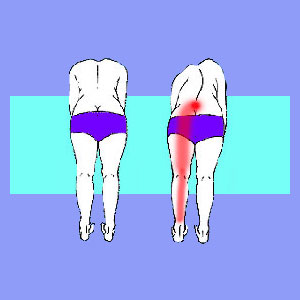
Sciatica stretches are often prescribed as part of a conservative exercise therapy or physical therapy program for neuralgia conditions. Stretching is a healthy fitness activity, which can help increase strength and flexibility. However, stretching is certainly not likely to become a miracle cure for sciatica or most any other type of back pain.
This article talks about how and why stretching is used to treat sciatic nerve complaints. We will explore the justifications for stretching, when recommended by professional caregivers, as well as what patients might expect if they begin an active stretching program.
Purpose of Sciatica Stretches
Stretches specifically performed to help sciatic nerve pain typically target the lower back and upper legs. Some therapists believe that sciatica might come from overly tight muscles or muscle imbalances.
Stretching is performed to deal with these theoretically painful issues, along with targeted exercise routines. If these diagnostic theories are correct, then stretching and exercise treatment is likely to produce shockingly good results.
Stretches will work the muscles, ligaments and tendons, but will not usually have any effect whatsoever on the nerves or spinal structures. Therapists who claim that stretches will cure spinal-induced sciatica are typically even less enlightened that the rest of the clueless care providers who prescribe completely inappropriate treatment modalities.
Stretches might help to alleviate pseudo-sciatica symptoms due to piriformis or sacroiliac concerns.
Benefits of Stretching for Sciatic Nerve Pain
For actual spinally-enacted sciatica pain, stretches will do absolutely no good at all. Stretches will not help a herniated disc, degenerative disc disease or any form of osteoarthritis which might be causing spinal nerve root compression. Why stretches are prescribed at all for these conditions is be beyond my logic. However, some patients do indeed benefit from stretching, even given a spinal diagnosis. This goes to prove once again, that some sciatic nerve syndromes are the direct result of ischemia, or another soft tissue pathology, rather than a spinal causation.
Stretching increases circulation and therefore cellular oxygenation. This temporarily alleviates the symptoms of oxygen deprivation sciatica and provides a few hours of relief.
Ironically, the very same care providers who prescribe stretches to treat what they think to be structural sciatica can not always explain why or how these exercises will help the spinal condition. They certainly can explain why stretches will work wonders for an ischemia-based pain syndrome. Still, they do not typically accept that most sciatica is the direct result of oxygen deprivation. Go figure.
Considerations Regarding Sciatica Stretches
If you receive no relief at all from stretching and exercise, there is an increased chance that your pain might actually be caused by that spinal condition which may have been diagnosed. However, if your pain does respond to exercise and stretching, the chances that you have been misdiagnosed have just gone up significantly. Remember, exercise works as a good temporary therapy for oxygen deprivation, muscle imbalances and piriformis syndrome, but does not change the structure of your spine.
During the early decades of suffering with sciatica back pain, I was told by many doctors and therapists that I should stretch more and do more exercise. I have 4 black belts in various martial arts styles and work out constantly. I am, and have always been, in superb physical shape, despite my back pain. In addition, I am a certified fitness trainer and completely understand the benefits of exercise and stretching 100%. I found this advice a bit ignorant and insulting, especially coming from some of these doctors who looked as if they sat around eating donuts all day and night.
Ok, here is the bottom line: Stretching is good. Stretching is healthy. Stretching should not cure spinally-motivated sciatica or provide any significant lasting relief. If stretching does help considerably, reconsider a spinal diagnosis, since it might very well be faulty.
Personally, I think stretching is very critical to overall health and wellness and is very good for the back. This is why I wrote a book detailing my own program of exercise and stretching, which can be found on our Cure Back Pain Forever Program page.





